 W
WThe ashy cisticola is a species of bird in the family Cisticolidae. It is found in Ethiopia, Kenya, Somalia, South Sudan, and Tanzania. Its natural habitats are dry savanna, subtropical or tropical dry shrubland, and subtropical or tropical dry lowland grassland.
 W
WThe Auckland shag or Auckland Islands shag is a species of cormorant from New Zealand. The species is endemic to the Auckland Islands archipelago. It is a sedentary bird that primarily eats various crustaceans and fish. In recent years, roughly 1,000 pairs have been recorded. The Auckland shag is a colonial nester, building sizeable nests of, among other items, grass, twigs and seaweed. The Auckland shag lays three pale blue-green eggs in November–February. The incubation period is 26–32 days.
 W
WThe Baja pygmy owl or cape pygmy owl, is a subspecies of northern pygmy owl restricted to the Mexican state of Baja California Sur. Although some taxonomists, including the International Ornithologists' Union, consider it to be a distinct species, other authorities, including the American Ornithological Society, do not consider it separate, and consider it to be a subspecies of the northern pygmy owl.
 W
WThe bare-headed laughingthrush is a species of bird in the family Timaliidae. It is endemic to highland forests in northern Borneo. It was formerly considered a subspecies of the black laughingthrush.
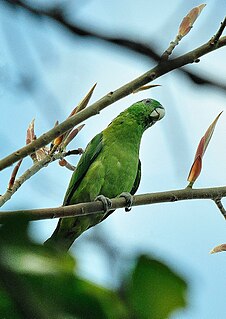 W
WThe blue-headed racket-tail, also known as the Palawan racket-tail and locally as kinawihan, is a parrot found in the western Philippines around Palawan. It inhabits humid lowland forest in small flocks. It is threatened by habitat destruction and limited trapping for the cage-bird trade.
 W
WThe Bolivian warbling finch is a species of bird in the family Thraupidae. It is found in Argentina and Bolivia. Its natural habitat is subtropical or tropical high-altitude shrubland.
 W
WThe Bonin petrel is a seabird in the family Procellariidae. It is a small gadfly petrel. The species is native to the North Pacific Ocean. Its secretive habits, remote breeding colonies and limited range have resulted in few studies and many aspects of the species' biology are poorly known.
 W
WThe Bornean green magpie is a passerine bird in the crow family, Corvidae. It is endemic to montane forests on the southeast Asian island of Borneo. It was formerly included as a subspecies of the Javan green magpie, but under the common name Short-tailed Green Magpie. Uniquely among the green magpies, the Bornean green magpie has whitish eyes.
 W
WThe Bornean stubtail is a species of bird in the family Cettiidae. It is endemic to the island of Borneo. The population is suspected to be stable in the absence of evidence for any declines or substantial threats. The species is reported to be a common bird above 2,000 m.
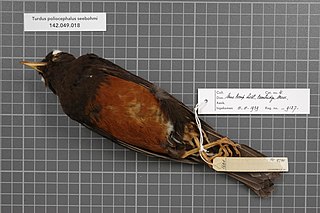 W
WThe Borneo thrush, also known as the mountain blackbird or locally in Dusun as Luhui tana, is a bird in the thrush family. It is a subspecies of the island thrush endemic to the island of Borneo.
 W
WThe Bougainville monarch is a species of bird in the family Monarchidae. It is endemic to Solomon Islands. Its natural habitats are subtropical or tropical moist lowland forests and subtropical or tropical moist montane forests.
 W
WBuller's shearwater is a Pacific species of seabird in the family Procellariidae; it is also known as the grey-backed shearwater or New Zealand shearwater. A member of the black-billed wedge-tailed Thyellodroma group, among the larger shearwaters of the genus Ardenna, it forms a superspecies with the wedge-tailed shearwater.
 W
WThe chestnut-backed sparrow-weaver is a species of bird in the family Ploceidae.
 W
WThe chestnut-naped spurfowl is a species of bird in the pheasant family Phasianidae. At 33–37 cm (13–15 in) in length and weighing 550–1,200 g (19–42 oz), it is a large species of spurfowl. It is found in Ethiopia and northern Somalia. The population is believed to be stable but according to the International Union for Conservation of Nature (IUCN) there is insufficient data to make an estimate of the population.
 W
WThe Christmas boobook, also known more specifically as the Christmas Island hawk-owl, is a species of owl in the family Strigidae.
 W
WThe Cinderella waxbill is a near-threatened species of estrildid finch found in drier regions of south-western Angola around Namibe Province, north and east to south-west Huila Province and north to Fazenda do Cuito in Huambo and extreme north-western Namibia. It has an estimated global distribution of 95,700 km2.
 W
WThe crested hornero is a species of bird in the family Furnariidae. It is found in Argentina, Bolivia, and Paraguay. Its natural habitat is subtropical or tropical dry shrubland.
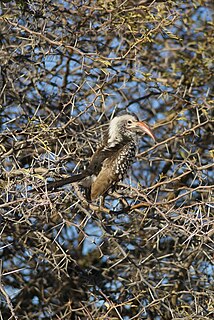 W
WThe Damara red-billed hornbill is a species of hornbill in the family Bucerotidae. It is found in southwest Angola and northern Namibia. All five red-billed hornbills were formerly considered conspecific.
 W
WThe Ecuadorian seedeater is a species of bird in the cardinal family Cardinalidae. It is found in the Andes in south-western Colombia through Ecuador to northern Peru. This species was formerly treated as a subspecies of what was the blue seedeater and is now Cabanis's seedeater.
 W
WThe emperor bird-of-paradise, also known as emperor of Germany's bird-of-paradise, is a species of bird-of-paradise.
 W
WThe erect-crested penguin is a penguin endemic to the New Zealand region and only breeds on the Bounty and Antipodes Islands. It has black upper parts, white underparts and a yellow eye stripe and crest. It spends the winter at sea and little is known about its biology and breeding habits. Populations are believed to have declined during the last few decades of the twentieth century, and the International Union for Conservation of Nature has listed it as being "endangered".
 W
WThe eyebrowed jungle flycatcher is a species of bird in the Old World flycatcher family Muscicapidae. It is endemic to the island of Borneo. The natural habitat of the eyebrowed jungle flycatcher is subtropical or tropical moist montane forests. It builds an open, mossy cup nest, generally in epiphytes or spiny palms.
 W
WThe friendly bush warbler, also known as the Kinabalu friendly warbler, is a species of Old World warbler in the family Locustellidae. It is endemic to the island of Borneo.
 W
WProgura is an extinct genus of megapode that was native to Australia. It was described from Plio-Pleistocene deposits at the Darling Downs and Chinchilla in southeastern Queensland by Charles De Vis.
 W
WThe golden-backed weaver, also known as Jackson's weaver, is a species of bird in the family Ploceidae.
 W
WThe golden-naped barbet is a member of the family Megalaimidae. It is found in Indonesia and Malaysia, where it is endemic to the island of Borneo. Its natural habitats are subtropical or tropical moist lowland forest and subtropical or tropical moist montane forest.
 W
WThe green Manakin is a species of bird in the family Pipridae. It occurs in humid forest in lowlands and foothills. The distribution is disjunct, with one population in the western Amazon Basin and adjacent east Andean foothills in southeastern Colombia, eastern Ecuador and eastern Peru, and another population in the humid Chocó in eastern Panama, western Colombia and northwestern Ecuador. It has been suggested that the latter population may be a separate species, the Lita Manakin. As suggested by its common name both the male and the female of the green manakin are overall green. It remains fairly common locally, and is consequently considered to be of least concern by BirdLife International and IUCN.
 W
WThe Herald petrel is a species of seabird and a member of the gadfly petrels. The bird is 35–39 cm (14–15 in) in size, with an 88–102 cm (35–40 in) wingspan.
 W
WJankowski's bunting or rufous-backed bunting is a species of bird in the family Emberizidae.
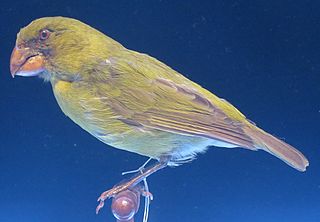 W
WThe Kona grosbeak is an extinct species of Hawaiian honeycreeper. The Kona grosbeak was endemic to naio forests on ʻaʻā lava flows at elevations of 1,400–1,500 metres (4,600–4,900 ft) near the Kona District on the island of Hawaii. The species was already very rare when it was first discovered, being found in only about 10 square kilometres (3.9 sq mi), and was last collected in 1894. Reasons for its extinction are not very well known. The genus is known from fossils from Kauai, Oahu and Maui. It was unknown to the Native Hawaiians, and thus a name for it does not exist in the Hawaiian language.
 W
WThe little pied flycatcher is a species of bird in the family Muscicapidae. It is found in the Indian Subcontinent and Southeast Asia, ranging across Bangladesh, Bhutan, Cambodia, India, Indonesia, Laos, Malaysia, Myanmar, Nepal, the Philippines, Thailand, and Vietnam.
 W
WThe Lord Howe boobook, also known as the Lord Howe morepork, was a bird in the true owl family endemic to Lord Howe Island in the Tasman Sea, part of New South Wales, Australia. It is an extinct and little-known subspecies of the morepork.
 W
WThe Madeiran chaffinch is a small passerine bird in the finch family Fringillidae. It is a subspecies of the common chaffinch that is endemic to the Portuguese island of Madeira, part of Macaronesia in the North Atlantic Ocean. It is locally known as the tentilhão.
 W
WThe Miombo rock thrush is a species of bird in the family Muscicapidae. It is found in Angola, Botswana, Burundi, Democratic Republic of the Congo, Malawi, Mozambique, Rwanda, Tanzania, Zambia, and Zimbabwe. Its natural habitat is dry savanna.
 W
WThe mountain blackeye is a species of bird in the family Zosteropidae. It is endemic to the island of Borneo.
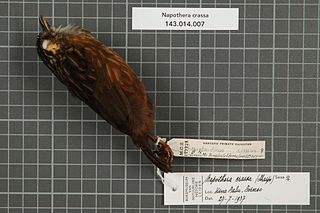 W
WThe mountain wren-babbler is a species of bird in the family Pellorneidae. It is found in Iran Mountains of northeastern Borneo. Its natural habitats are subtropical or tropical moist lowland forest and subtropical or tropical moist montane forest.
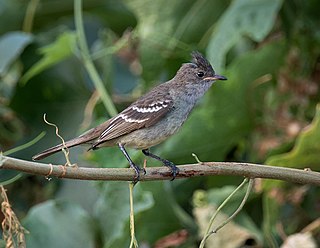 W
WThe Noronha elaenia is a species of bird in the tyrant-flycatcher family Tyrannidae. It is endemic to Fernando de Noronha, a small archipelago off the coast of Brazil. The species was formerly considered a subspecies of the large elaenia, but differs considerably in the calls and song.
 W
WThe northern brown-throated weaver is a species of bird in the family Ploceidae. It is found in Uganda, Rwanda and adjacent northern Burundi, eastern Democratic Republic of the Congo, western Kenya and northwestern Tanzania.
 W
WThe Palawan flowerpecker is a species of bird in the family Dicaeidae. It is endemic to the Philippines.
 W
WThe Palawan flycatcher is a species of bird in the family Muscicapidae. It is endemic to the Philippines.
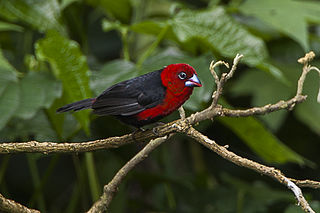 W
WThe red-headed bluebill is a common species of estrildid finch found in Sub-Saharan Africa.
 W
WReichenow's seedeater is a species of finch in the family Fringillidae. It is sometimes considered conspecific with the black-throated canary.
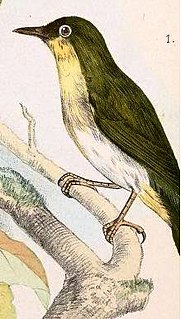 W
WThe Sangihe white-eye is a species of bird in the white-eye family. It is endemic to Sangihe, Indonesia.
 W
WThe São Tomé olive pigeon or maroon pigeon is an endangered species of pigeon which is endemic to the island of São Tomé off the coast of western Africa. It was described by José Vicente Barbosa du Bocage in 1888.
 W
WThe scarce swift is a species of swift in the family Apodidae. It has a disjunct range of presence throughout the Afromontane : Cameroon line, Albertine Rift montane forests, Kenya, Tanzania, Malawi and Mozambique.
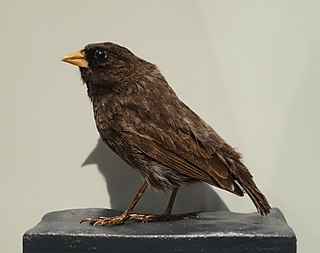 W
WThe sharp-beaked ground finch is a species of bird in the Darwin's finch group of the tanager family Thraupidae. It is classified as a least-concern species by the International Union for Conservation of Nature and it is native to the Galápagos Islands in Ecuador. It has a mass of around 20 grams (0.71 oz) and the males have black plumage, while females have streaked brown plumage. This finch was described by Richard Bowdler Sharpe in 1888.
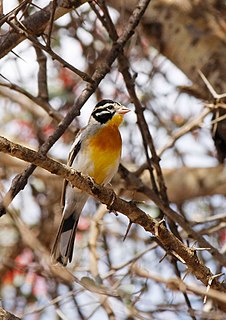 W
WThe Somali bunting or Somali golden-breasted bunting is a species of bird in the family Emberizidae.
 W
WThe southern red-billed hornbill is a species of hornbill in the family Bucerotidae, which is native to the savannas and dryer bushlands of southern Africa. It is replaced by a near-relative, the Damara red-billed hornbill, in the arid woodlands of western Namibia. All five red-billed hornbills were formerly considered conspecific.
 W
WWhitehead's broadbill is a species of bird in the family Calyptomenidae. It is restricted to montane forests in northern Borneo. It is the largest species in the genus Calyptomena and is named after the British explorer John Whitehead (1860–1899) who collected specimens and studied natural history in Borneo and elsewhere in southeast Asia.
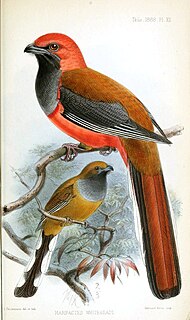 W
WWhitehead's trogon is a species of bird in the family Trogonidae. It is endemic to the island of Borneo. Its natural habitat is subtropical or tropical moist montane forests. It is threatened by habitat loss. It is named after the British explorer John Whitehead (1860–1899) who collected natural history specimens in Borneo and elsewhere in Southeast Asia. Whitehead's trogon nest in cavities and their nesting habits can be viewed at this link. https://www.youtube.com/watch?v=oTbbZ6CDtDc